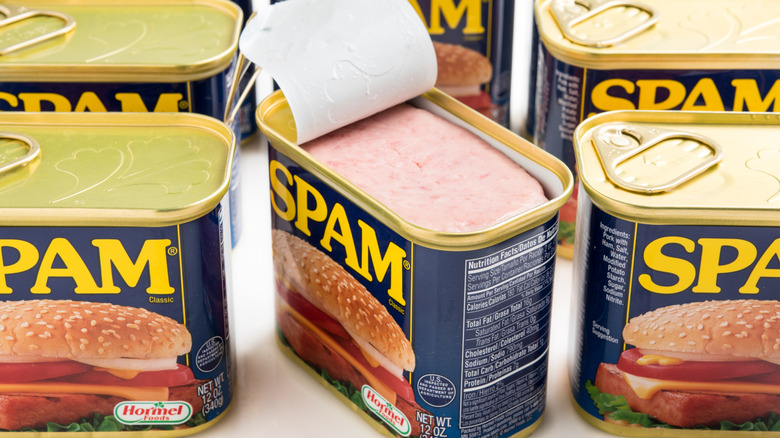The Popular Canned Meat That's Also One Of The Unhealthiest
Spam has managed to stay on grocery shelves for nearly nine decades, but not always for reasons that make nutritionists happy. The pink block of pork shoulder and ham has inspired cookbooks, memes, and even a Monty Python sketch, while still dividing opinion between loyal fans and those who won't touch it. Its enduring appeal comes from convenience, but its reputation as a questionable health choice has followed it for just as long.
For those wondering what Spam even is (and how it is made), the recipe is surprisingly bare-bones: just pork shoulder, ham, salt, water, sugar, potato starch, and sodium nitrite for color and preservation. The result is a precooked loaf encased in a thin layer of gelatin, ready to eat straight from the tin — though some people prefer it fried until golden. Its long shelf life and convenience are exactly what helped it gain traction during hard times.
World War II played an essential role in Spam's popularity, cementing its place in American pantries and beyond. Soldiers were fed it regularly, and when the war ended, Spam had already woven itself into the fabric of cuisines around the world — from Hawaii to South Korea. But the same qualities that made it cheap, filling, and long-lasting also meant it was heavy on fat and salt, a trade-off that would later spark plenty of debate about its place in the modern diet.
The salty truth behind Spam
Spam's nutritional profile makes it one of the unhealthiest canned meats you can buy. A single 2-ounce serving has 174 calories and 15 grams of fat, plus almost a third of your daily sodium allowance — and that's if you stop at just one portion. Most people slice it thicker, which only pushes the totals higher. Compared to a lean protein like chicken breast, Spam brings far more fat and calories to the table while offering noticeably less protein in return.
The problems don't end with the nutrition label. Spam is a processed meat, and studies have consistently tied regular intake of processed meats — even small amounts — to higher risks of heart disease, stroke, and type 2 diabetes. Heavy sodium content compounds the issue, especially for people with high blood pressure or salt sensitivity, since it can strain circulation and cause bloating. In other words, the same preservatives that keep Spam shelf-stable are also part of what makes it a dietary red flag.
Even regulators have raised concerns. In August 2023, the U.S. Department of Agriculture issued a public health alert after Hormel reported that a batch of Spam Classic might not have been processed adequately to guarantee commercial sterility. No illnesses were confirmed, but the episode showed that even a food built to last can raise questions about safety. Spam may have survived wars and recessions, but today, its biggest battle is proving it still deserves a place at the dinner table.

